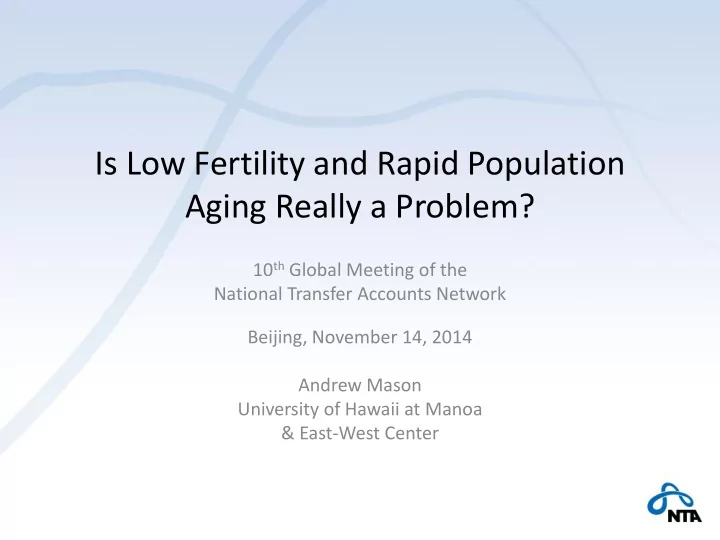

Is Low Fertility and Rapid Population Aging Really a Problem? 10 th Global Meeting of the National Transfer Accounts Network Beijing, November 14, 2014 Andrew Mason University of Hawaii at Manoa & East-West Center
Based on: Ronald Lee, Andrew Mason, Eugenia Amporfu, Chong-Bum An, Luis Rosero Bixby, Jorge Bravo, Marisa Bucheli, Qiulin Chen, Pablo Comelatto, Deidra Coy, Hippolyte d'Albis, Gretchen Donehower, Latif Dramani, Alexia Fürnkranz- Prskawetz, Robert I. Gal, Mauricio Holz, Nguyen Thi Lan Huong, Fanny Kluge, Laishram Ladusingh, Sang-Hyop Lee, Thomas Lindh, Li Ling, Giang Thanh Long, Maliki, Rikiya Matsukura, David McCarthy, Iván Mejía-Guevara, Teferi Mergo, Tim Miller, Germano Mwabu, M.R. Narayana, Vanndy Nor, Gilberto Mariano Norte, Naohiro Ogawa, Olanrewaju Ademola Olaniyan, Javier Olivera, Morne Oosthuizen, Mathana Phananiramai, Bernardo Lanza Queiroz, Rachel H. Racelis, Elisenda Rentería, James Mahmud Rice, Joze Sambt, Aylin Seçkin, James Sefton, Adedoyin Soyibo, Jorge A. Tovar, An-Chi Tung, Cassio M. Turra, B. Piedad Urdinola, Risto Vaittinen, Reijo Vanne, Marina Zannella, Qi Zhang, 2014 “Is Low Fertility Really a Problem? Population Aging, Dependency, and Consumption,” Science (346) 229-234 . DOI: 10.1126/science.1250542. Andrew Mason November 14, 2014
ISSUE • Widespread concern that low fertility and rapid population aging will lead to: – Severely strained public budgets – Reduced standards of living • Governments of more than 50 countries reported to the UN that their birth rates were too low. • Many governments are adopting programs to encourage couples to have more children. Andrew Mason November 14, 2014
Findings • Moderately low birth rates, below replacement fertility, are actually ideal for achieving a high material standard of living. • Fiscal problems can be addressed by: – Investing more, and more effectively, in human capital – Adjusting retirement ages and eligibility for public support in response to the improved health of older adults – Adjusting public spending and tax systems as needed • Only if birth rates are very low, should governments actively pursue pro-natalist policies. Andrew Mason November 14, 2014
Low Fertility Does Create Fiscal Problems Andrew Mason November 14, 2014
Evidence: Public Sector Public transfer inflows Public transfer outflows • Detailed estimates of 0.9 public benefits and 0.8 Annual flow/Labor income (30-49) taxes paid at every Japan age in 29 economies. 0.7 • 0.6 Determined the fertility rate the 0.5 would produce an 0.4 age structure 0.3 allowing the highest 0.2 age-specific benefits 0.1 per tax dollar spent. 0.0 0 20 40 60 80 100 Age Andrew Mason November 14, 2014
Fiscal support ratio for Japan Current balance of taxes and spending is SRG summarizes the unsustainable adjustments to taxes and/or 1 spending required to maintain current balance between inflows and 0.9 outflows. Best possible outcome Fiscal support ratio 0.8 • TFR of 2.7 and mean age in the mid-30s • Spending cut of 16% or 0.7 • Tax increase of 19% 0.6 Status quo outcome • TFR of 1.34 and mean age in the mid-50s 0.5 • Spending cut of 30% or 20 25 30 35 40 45 50 55 60 65 70 Mean age of population • Tax increase of 45% Given age profiles of public transfer inflows and outflows and 2009 mortality schedule. Andrew Mason November 14, 2014
Andrew Mason November 14, 2014
Moderately Low Fertility Is Best for Standards of Living Andrew Mason November 14, 2014
Evidence: Standards of Living • Detailed estimates of public benefits received and taxes paid at every age in 29 economies. • Detailed estimates of private costs and benefits at every age in 40 economies. • Capital costs of a larger labor force. • Determined the fertility rate that would produce an age structure allowing the highest level of consumption at every age. Andrew Mason November 14, 2014
Current TFR and TFRs that maximize standard of living Income group Current Standard of Living TFR K/Y=OECD S/Y = average Golden rule Upper-middle 2.19 1.52 1.20 income High income 1.58 1.79 1.48 - low TFR 1.35 1.74 1.44 - high TFR 1.88 1.86 1.54 Upper-middle income Economies: Argentina, Brazil, Chile, Colombia, Costa Rica, Jamaica, Mexico, Peru, South Africa, Turkey, and Uruguay. High income Economies: TFR<1.5: Austria, Germany, Hungary, Italy, Japan, Slovenia, South Korea, Spain. TFR>1.5: Australia, Canada, France, Sweden, UK, US. Andrew Mason November 14, 2014
Andrew Mason November 14, 2014
Effect of TFR on Consumption (K/Y = 3, own mortality schedule) Very low birthrate of 1.3 births per woman will reduce consumption by about 7%. Note: Average values for NTA economies using their current survival schedule and consumption and labor income profiles. Andrew Mason November 14, 2014
Summary • Changes in age structure in recent decades have led to a very favorable but transitory demographic dividend. • Going forward, for any demographic scenario, major adjustments to the public sector will be required. • In most countries, encouraging higher fertility is the wrong answer. It will lead to lower standards of living. • In a few countries with VERY low fertility, pro-natalist policies should be explored. Andrew Mason November 14, 2014
Recommend
More recommend